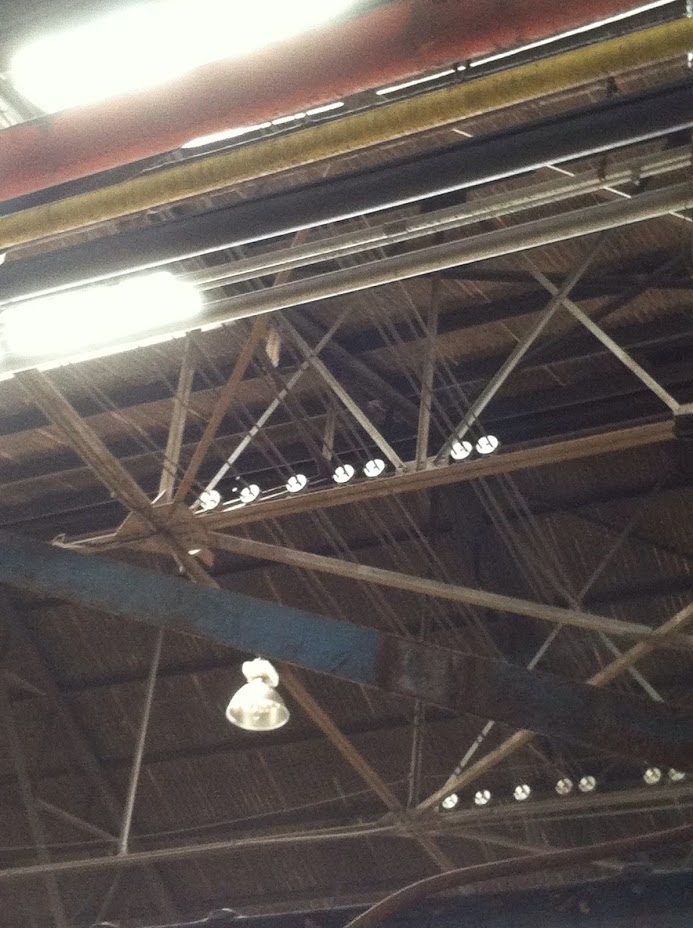MBeach
Member
- Location
- Birmingham, AL
First post here, lurked for a while. I would appreciate any help you guys can give.
Yesterday I was asked to look at a couple of old industrial buildings that had been partially vandalized with wiring removed. I am tasked with determining whether the existing wiring is usable. If not, the owners would like to remove the wiring and scrap the wire. For the life of me, I have never seen a system like this, so I don't know where to begin to research on whether it may be usable or not.
The buildings were built around 1900-1920. When originally built, they were home to a railcar manufacturer. The buildings range from 1000-2500 feet long by 100-200 feet wide.
The wiring in question comes directly from the transformer, up the wall, and enters the building above the bottom of the ceiling joists. In some spots, there are up to 21 what appears to be 250 MCM wires running perpendicular to the length of the building. These wires are supported in groups of 3 by porcelain disc insulators. At various intervals, these wires tap groups of 3 500 mcm wires that run the length of the building. At each end of the run, there is a tensioning mechanism that pulls the wire tight. These wires also are supported by porcelain insulators. The wire itself appears to be insulated via a woven fabric over a rubber type insulation.
It appears that wherever power was needed throughout the building, taps were made on the 500s using either split bolts or soldering, and the wire ran into a pipe down the wall to the various switchgear, which usually consisted of a fusable disconnect. From there, it branched off like any other older style electrical installation.
In my opinion, this appears to be some sort of knob and tube configuration, but I honestly am not sure. I have never come across anything like this, which is why I am humbly asking the opinion of this board.
One building has not been touched by thieves, the wiring is completely intact. Another has had portions cut out. Would it be possible to repair the wiring that has been disturbed? Would it be possible to repower the building that has not been touched without problem? Is this systems still acceptable under the current NEC?
Thanks, and I appreciate any help you could provide.
View attachment 8302
View attachment 8303
View attachment 8304


Yesterday I was asked to look at a couple of old industrial buildings that had been partially vandalized with wiring removed. I am tasked with determining whether the existing wiring is usable. If not, the owners would like to remove the wiring and scrap the wire. For the life of me, I have never seen a system like this, so I don't know where to begin to research on whether it may be usable or not.
The buildings were built around 1900-1920. When originally built, they were home to a railcar manufacturer. The buildings range from 1000-2500 feet long by 100-200 feet wide.
The wiring in question comes directly from the transformer, up the wall, and enters the building above the bottom of the ceiling joists. In some spots, there are up to 21 what appears to be 250 MCM wires running perpendicular to the length of the building. These wires are supported in groups of 3 by porcelain disc insulators. At various intervals, these wires tap groups of 3 500 mcm wires that run the length of the building. At each end of the run, there is a tensioning mechanism that pulls the wire tight. These wires also are supported by porcelain insulators. The wire itself appears to be insulated via a woven fabric over a rubber type insulation.
It appears that wherever power was needed throughout the building, taps were made on the 500s using either split bolts or soldering, and the wire ran into a pipe down the wall to the various switchgear, which usually consisted of a fusable disconnect. From there, it branched off like any other older style electrical installation.
In my opinion, this appears to be some sort of knob and tube configuration, but I honestly am not sure. I have never come across anything like this, which is why I am humbly asking the opinion of this board.
One building has not been touched by thieves, the wiring is completely intact. Another has had portions cut out. Would it be possible to repair the wiring that has been disturbed? Would it be possible to repower the building that has not been touched without problem? Is this systems still acceptable under the current NEC?
Thanks, and I appreciate any help you could provide.
View attachment 8302
View attachment 8303
View attachment 8304

Last edited:

